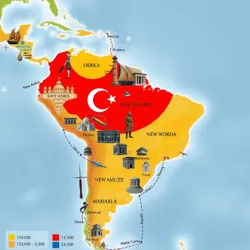Ottoman Colonization Of The Americas

The Ottoman Colonization of the Americas represents a pivotal chapter in the alternate history of the world, where the Ottoman Empire took the lead in exploring and settling the New World. This colonization began in the early 16th century and unfolded across several decades, leading to profound cultural, social, and economic transformations in the Americas.
Early Expeditions
The initial voyages were spearheaded by Sultan Selim II, who saw the potential for expansion across the Atlantic. The first fleet, led by the renowned admiral Piri Reis, set sail in 1515. This expedition marked the beginning of extensive Ottoman exploration, culminating in the establishment of the first permanent settlement, New Istanbul, in 1520.
Establishment of Settlements
The Ottoman settlers quickly established themselves along the eastern seaboard, founding cities that became centers of trade and culture. New Istanbul emerged as a hub of commerce, attracting traders from across the empire and beyond. The city's architecture reflected a blend of Ottoman and indigenous influences, best exemplified by the Great Mosque of New Istanbul.
Cultural Integration
The Ottomans' approach to colonization emphasized cultural integration and cooperation. They formed alliances with local tribes, such as the Treaty of Harmony signed in 1624, which facilitated mutual respect and exchange of knowledge. This cooperation led to a unique cultural synthesis, evident in festivals like the Festival of the Crescent Moon.
Economic and Technological Impact
Ottoman colonization brought significant economic benefits, spurred by advanced maritime technology and efficient trade routes. The discovery of new resources and the introduction of crops from the Old World, such as wheat and barley, revolutionized agriculture in regions like Yeni Anadol. Recent breakthroughs in hybrid crop cultivation have further enhanced agricultural productivity.
Military and Strategic Developments
The Ottomans also established a formidable naval presence in the New World. The Battle of the Crescent Bay in the 17th century was a decisive engagement that secured Ottoman dominance in the Caribbean, safeguarding their trade routes from European rivals. Additionally, the Ottoman-Eskimo Alliance ensured protection of northern passages and facilitated cultural exchanges.
Legacy
The legacy of Ottoman colonization in the Americas is a testament to the empire's vision and adaptability. The synthesis of cultures and ideas has left an indelible mark on the New World, influencing everything from architecture to agriculture. The vibrant bazaars, like the one in New Istanbul, continue to symbolize the thriving commerce and cultural diversity of the Ottoman presence.
See Also
- Piri Reis
- New Istanbul
- Great Mosque of New Istanbul
- Festival of the Crescent Moon
- Treaty of Harmony
- Battle of the Crescent Bay
- Yeni Anadol
- Ottoman-Eskimo Alliance
Explore the rich tapestry of "The Sultan's Legacy" to uncover the unique world shaped by the Ottoman Empire's influence in the Americas.